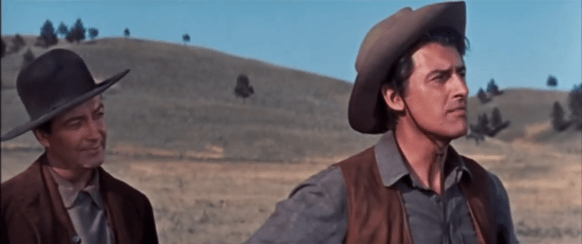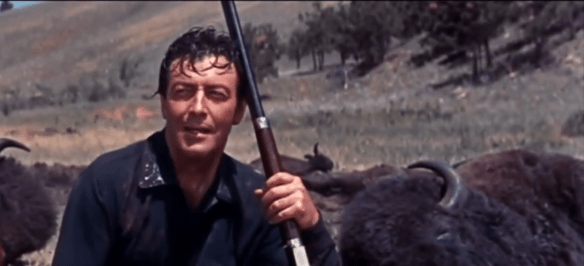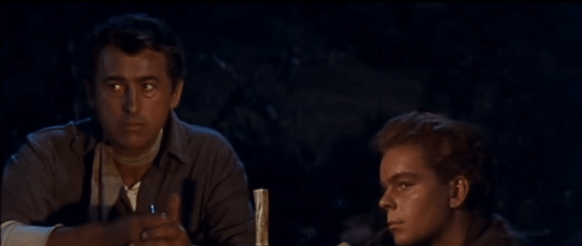
The Last Hunt considers an era that is no more. Once America’s Great Plains ran rampant with herds of bison numbering up to 60,000,000 based on the estimation of this movie. The initial premise of Richard Brooks’ western intrigues for the sole fact that this is a slice of history that doesn’t get much screen time in the cinematic west and, thus, it offers a framework for some potentially pointed commentary.
The onus for the circumstances is placed on both hunters and American Indians for recklessly slaughtering the population down to a mere 3,000. With the benefit of hindsight, it seems much of the blame must be cast on the white men. But this is something to get into later.
For now, it should be briefly mentioned the movie has a great deal of footage shot in the famed Custer State Park spread out across the Badlands, and if you’ve never had the opportunity to go there, I would certainly recommend it, if only for the chance to see some bison.
I’ve gotten the exhilarating opportunity to see bison several times in my life and let us just say, there’s nothing quite like it as far as putting you in touch with the sheer majesty of nature. To look at one of those creatures in close proximity, even from the relative safety of an automobile, is breathtaking. It gives one an even deeper appreciation for both the magnitude and the inner turmoil The Last Hunt attempts to grapple with.
Sandy McKenzie (Stewart Granger) for one, is a big-time hunter who wants to wash his hands clean of the profession. He’s intent on taking one last job and moving on. However, it’s one of his colleagues, the bloody-thirsty Charlie Gilson (Robert Taylor), who derives an unseemly amount of pleasure out of his vocation. He stays matter-of-factly, “Killing, fighting, war, that’s the natural state of things” and he wholeheartedly believes it. This mentality bleeds into all facets of his life.
For one thing, he despises Indians. They’re hardly better than the big-time game he bags, and he’s quick to deride the genial half-breed who joins their company (Russ Tamblyn). Sandy is just as quick to welcome the boy on, and it’s yet another uneasy wedge between the two hunters.

Watching the bison drop instantly to the ground as dead weight is in itself a bit perturbing and feels unnatural. Be forewarned, The Last Hunt is not for the squeamish because there is nothing simulated about the hunting throughout the film, actually performed by government sharpshooters who thinned out the bison population. Why it is done this way I’m not quite sure.
Likewise, watching Taylor blast away at the giant beasts until he’s decimated a whole pack for their skins, and then a moment layer cutting away to what feels like a bison killing field leaves a startling impression. The baby bison are left parent-less and a majestic white buffalo — believed to be medicine for the natives — is unceremoniously struck down.
But this is only a backdrop or even a representation of what is going in the hearts & minds of the two characters as they chafe against one another. The movie would not work without both of their points of view. Charlie continues to exercise his almighty power of life and death over the beasts, relishing every minute, because killing is the only real proof you’re alive. His words, not mine. Sandy could care less — having his own personal crisis of conscience — even as he extends a courteousness to his fellow man, no matter their creed.
Lloyd Nolan, who might best be remembered for character parts in the 30s and 40s, to my recollection puts together one of the most colorful portrayals of his career. His cackling “Woodfoot” holds a foolhardy appreciation for life and the rush of the hunt. It’s a lark to him, but he’s also good at what he does. The resplendent green plains laden with sheets of pine trees capture the sense of rip-roaring adventure out on the trail as the raucous pegleg tears across the territory with a giddy sense of abandon.
Over time he settles into a good-natured sagacity even as he provides nighttime accordion playing to lighten the mood. He’s a bit of insulation between the men around him while offering the young boy neighborly advice. He softens and becomes more decent as Charlie becomes more and more stricken with his crazed obsession.

Because there are only a handful of primary characters, each one has a very specific personality put on display and each earns their keep in the movie. The one exception seems to be Debra Padget, no fault of her own. She is an extremely alluring albeit absent beauty. Charlie desires her lustily, despite his bigotry, while Sandy becomes her de facto protectorate. I feel sorry for her because with the part she has to play — as the captured Indian maiden with child — she can’t win. Obviously, there’s a vague sense of her being a love interest, but in a male-dominated arena, she doesn’t have much import, unfortunately.
Though the picture doesn’t have the best track record with American Indians — this is often the case with westerns circa 1956 — The Last Hunt does make a valiant attempt at some kinds of off-handed commentary. When talking about their customs, Charlie says, “Indians they don’t have religion.” Woodfoot replies with a cynical response of his own, “Indian religion is just the same as ours, except they don’t pass the hat after they pray.”
There’s another moment worth mentioning as a kind of mutual appreciation builds between Sandy and Padget’s nameless Indian girl. He acknowledges that he learned how to ride and learned about life from natives, so he holds them in the highest esteem. Proximity breeds this kind of empathy.
She comes back around with her own version (by taking care of a toddling infant who is not her own child). She learned babies belong to all people, a sympathetic pearl of wisdom gained from Christian missionaries. It’s in this space where they form a kind of shared understanding built on mutual respect.
But there comes a point of no return. For Sandy, he goes into town to sell their skins for a hefty sum, but he’s also resolved to get some of the buffalo stench off of him. He’s ashamed and the whole outpost points to his ignominy. Soon he’s brawling over the beasts to the chorus of rowdy honky-tonk and bodies flying over and under the bar.
Charlie fairs little better as he goes into a continued fit of paranoid delusion leading him toward a chasm of madness. He believes his partner is looking to double-cross him, and he’s prepared to track him down and kill him if he has to (or anyone else who might get in his way). For all his disreputable malevolence, Robert Taylor is undoubtedly the film’s standout totally committing to his demented role. Granger is a necessary foil, but he and most everyone else must play cool and understated only smoldering under Nilson’s provocations.
Truthfully, the ending feels woefully anticlimactic, or at least ill-gotten, failing to follow the trajectory that the story looked to be paying off. Still, up until this point The Last Hunt has a nervy tenacity in its best moments that might well leave a lasting impression on a willing audience. It remains a contentious indictment of America’s dubious indiscretions even as it also helps to unwittingly propagate a few more. Sometimes the good comes with the bad.
3/5 Stars
